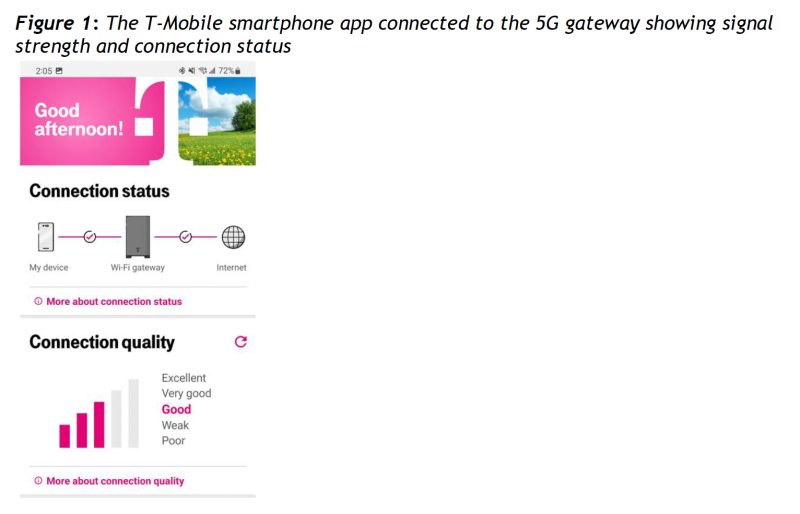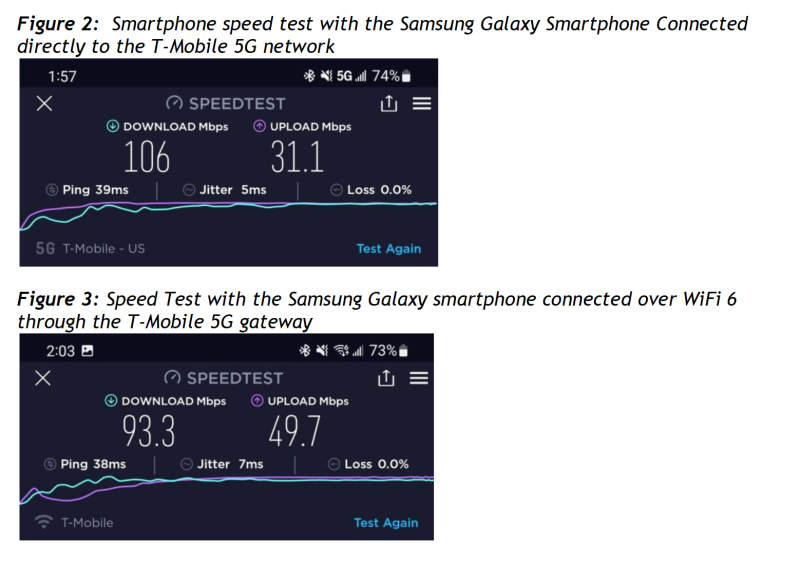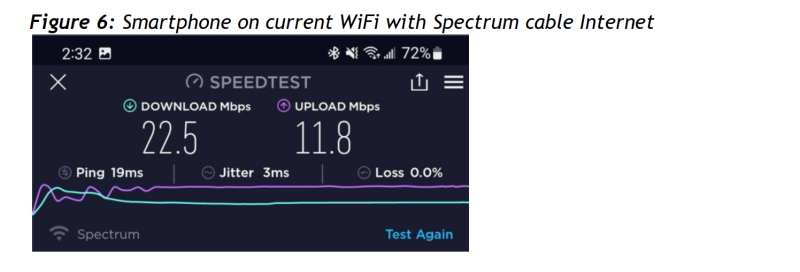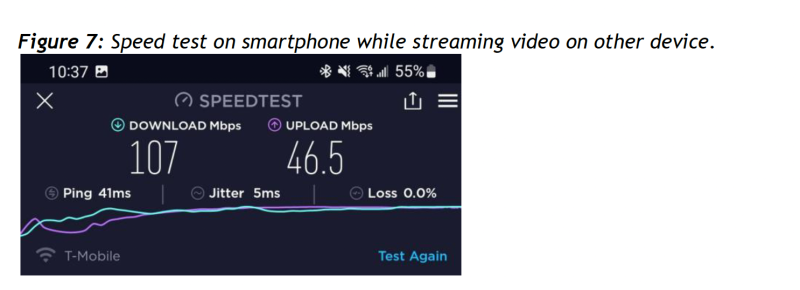
T-Mobile recently made its 5G-based fixed wireless access (FWA) broadband service available across the country, with the caveat that it would selectively deploy the service based on the user location in order to make sure there's enough capacity in that area so as not to negatively impact overall network performance. T-Mobile is offering a consumer oriented service for a flat $50 per month with all fees and taxes included. If you are in an area where there is only a single broadband provider, this is likely to be significantly less than they charge.
But how good is the T-Mobile FWA broadband service? We decided to give it a test drive to find out. Since the service is being offered to customers in select areas where the primarily smartphone-oriented network won’t be negatively affected by the typical broadband user data needs, we looked for a location that T-Mobile would approve service to. We have a location in Southern Maine where T-Mobile is offering its service, and that is where we conducted our tests.
In the area where we conducted our tests, an internet-only cable subscription from the sole provider is $75 per month. In contrast, T-Mobile will provide its top offering Magenta Max customers with the ability to add its broadband service for $30 per month – the equivalent of adding an additional line to its family plan.
Our test
In our case T-Mobile provided us with a Nokia-built gateway. It took about two minutes to fully boot up after we plugged the power brick into a wall outlet.
Setting up the 5G Fixed Wireless Access Gateway was actually very simple. You scan a QR code in the small quick setup guide, which leads you to downloading a T-Mobile app to your smartphone. Once the app is running (in our case we installed it on an Android-powered Samsung Galaxy device), it guides you through setting up the access point in just a few easy to follow steps.
The app, communicating with the gateway, verified that there was enough signal strength in the physical location of the access point. In our case, it was next to a second floor window on the side of the building facing the cell tower, which was approximately 1.5-2 miles away. After the signal strength test, the app suggests you change the default WiFi SSID and password during the setup using an easy to follow fill-in-the blanks screen. This is a much simpler process than required with most Wi-Fi access points. Changing the SSID and password are optional, but it’s always a good idea to add more security rather than just using the default settings. It took less than 10 minutes to go through the setup screens and get the access point up and running. Below is a screenshot of the T-Mobile app showing connection status and signal quality.

Signal strength and speed test
In our chosen location, the access point showed between 2 and 3 bars of signal strength (touching the top of the gateway enables a screen to show the signal strength). We thought that the less than optimal signal strength might be an issue, but it turned out not to be. To act as a control, we also ran the Ookla speed test on our smartphone device connected directly to the T-Mobile 5G network at that location. We then connected the smartphone to the 5G access point over its Wi-Fi 6 connection. Our tests were conducted on a Friday afternoon, so it’s possible that other days/times may show different results. Below are the speed test results:

We further tested the T-Mobile gateway with a PC to see if there was any significant difference from the smartphone speed test. The smartphone actually tested faster than the HP laptop we used for the test.
Finally, we wanted to test the strength of the gateway Wi-Fi signal, so we tested by moving to a lower floor and across the test location – probably a distance of about 75 feet line of sight. There was a small speed difference.
We also compared the T-Mobile gateway speed to the existing cable internet connection supplied by the local cable provider, Charter's Spectrum, which was accessed through a Wi-Fi access point (not Wi-Fi 6). It was substantially slower, part of which may have been due to not having a Wi-Fi 6 connection. However, streaming a video over this slower connection did not cause any significant issue for the sound and video display, although with the slower speeds, having multiple streams at the same time could be problematic.

Real world use test
We spent the following day streaming several movies from Amazon Prime to a large screen Android tablet, to see if there would be any glitches in the connections. We found no problems in watching the videos, with no sound or video disruptions. We also ran a speed test from our smartphone during the video streaming to see if it affected the ability for other devices to use the gateway. There did not seem to be any substantial degradation.

We did not try to run multiple streams on many devices concurrently to see about loading factors. That is for a future test run. However, we’d expect to see good performance on a reasonable number of devices, given the speed test data.
Caveats
While the tests were conducted in what we believe to be a realistic scenario, there are several caveats we would offer to this testing.
Since we only tested on two days, it’s quite possible that there are other days/times when the network would be more loaded and hence not as fast or reliable.
The location where the testing took place is a fairly low density suburban area so loading was probably not very high on the network, especially since this is early in the offering and few people relatively speaking have signed on for the home internet service. We would expect higher density locations to potentially see more loading. Still, T-Mobile has made a point of monitoring the number of users in any area to keep congestion in check, and that should keep any overloaded network issues to a minimum.
We only had a single device so our test was not reflective of a house full of users, especially if multiple streaming devices are on at once.
Many cable connections are now approaching 200 Mbps or more speed (some now approaching 1 Gbps), so the relatively slower 100 Mbps speed seen during the test is at the lower end of newer internet services. Still, for most users it’s more than adequate, especially as the average cable internet connections are 100-150 Mbps.
Low term reliability wasn’t tested, but generally speaking the cellular networks are highly reliable, so this is likely not an issue.
Bottom line
Our tests showed that the T-Mobile 5G Internet service is a viable competitor to more traditional internet service providers, at least in our test area. A densely populated urban area could show different results, but that is not where T-Mobile is targeting this service.
Our experience showed that the service offered extremely easy set-up, competitive speeds suitable for the needs of most users, and attractive cost. We believe the T-Mobile Internet service to be an excellent alternative to many high-cost cable connections and at adequate speeds (not Gigabits, but that may not be necessary for most users). It is also a terrific alternative to those on DSL, offering many times the speed. And of course, for those not currently served by cable or DSL, this is an onramp that enables connectivity, albeit only where T-Mobile has coverage. Overall, we’d rate this offering from T-Mobile as a win for consumers.
Jack Gold is the founder and principal analyst at J.Gold Associates, LLC. With more than 45 years of experience in the computer and electronics industries, and as an industry analyst for more than 25 years, he covers the many aspects of business and consumer computing and emerging technologies. Follow him on Twitter @jckgld or LinkedIn at https://www.linkedin.com/in/jckgld.
